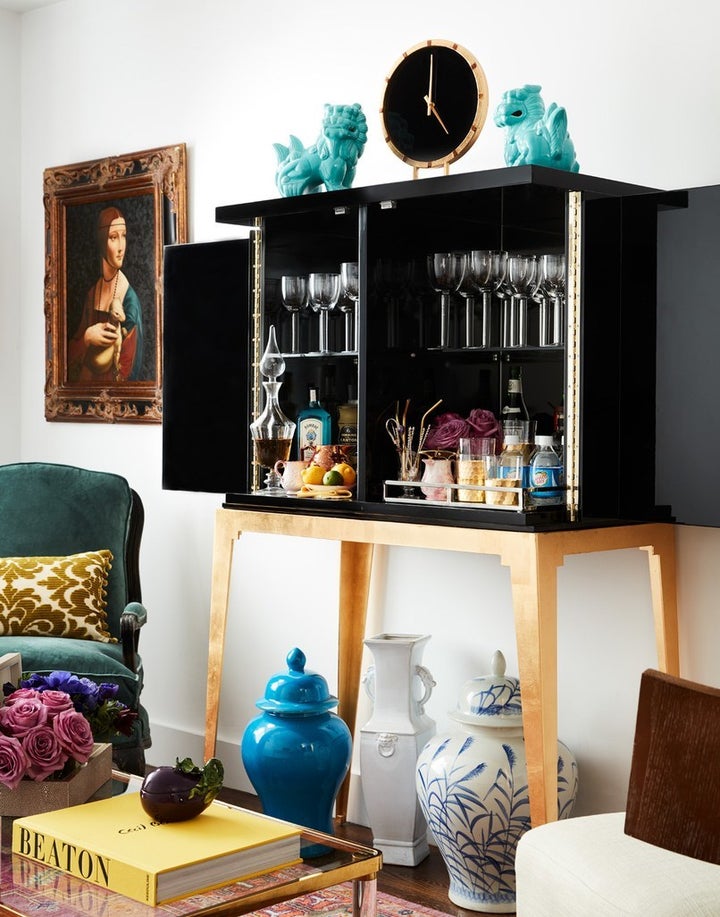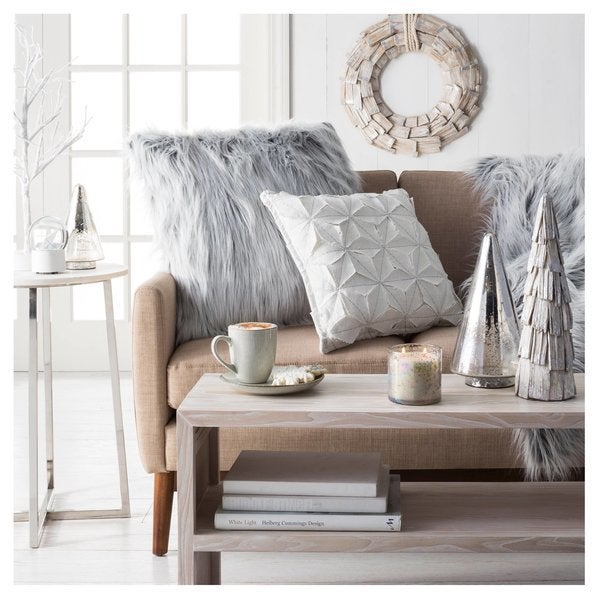For Architectural Digest, by Hadley Keller.
As urban and eco-conscious living becomes more prevalent, many homeowners are decorating not sprawling, multiroom homes, but more compact apartments and condos. We’re of the mind that good decor doesn’t discriminate by size, but packing a stylish punch into limited square footage can be tough. How many patterns is too many patterns? How to get a layered look without appearing just messy? What type of furniture won’t dwarf your space? To help answer these questions and more, AD turned to a few trusted designers to hear their take on the biggest mistakes they’ve seen clients make in small spaces — and how to avoid them.

A large bar cabinet makes a statement in a small space while providing ample (and attractive) storage.
Don’t Be Afraid to Think Big
By far the most popular advice we heard from designers was perhaps the most surprising: Don’t think everything has to be tiny just because the space is. “I often see people make the mistake of only using small-scale furniture in small spaces because they’re afraid a larger piece will overpower the room,” says Eddie Ross, designer and style director of ATGStores.com. “If space is tight, think big. You might be surprised what a single statement piece can do to make a small room feel grand.” Ross recommends the oversize Safavieh bar chest, shown above, for an avid entertainer. Bonus: Its height means you can use the space between its legs for storage.
Jon Maroto and George Nunno, founders of Flair Home, agree. “The biggest mistake to make when decorating a small space is to treat it like a small space,” they say. “We love to use dramatic oversized art, paint the room in a dark color, or use a bold piece of lighting to make a smaller space feel larger and special. It is important to find the balance and use a mixture of smaller- and larger-scale pieces.”
“By far the most popular advice we heard from designers was perhaps the most surprising: Don't think everything has to be tiny just because the space is.”
“The biggest mistake I see people making when decorating a small space is using too many small furniture pieces,” agrees designer Grace Rosenstein. “It seems counterintuitive, but usually a few pieces of moderately sized furniture combined with an efficient floor plan will make the space feel much bigger, while creating less clutter and more functionality.”
It’s no surprise that designer Sasha Bikoff, known for her daring, colorful rooms, is on the same page. “There is a common misconception that when you have a small space, you have to have keep it minimal with furniture and color,” she says. “I like to create what I call a ‘Christian Dior jewel box.’ The idea is to pack as much punch as possible into the space and create an experience. Painting walls and ceilings will make a space feel larger.”
Plan, Plan, Plan
Having a sound design plan is important in all spaces, but it’s especially crucial for smaller ones. “The biggest mistake when decorating small spaces is not having a furniture plan in place,” says Annsley McAleer of Annsley Interiors. “Small spaces require careful thought, and every inch matters. Avoid furniture with dramatic arms and let the slipper chair be your friend!”
Pick the Right Rug!
When it came to carpets, designers seemed to be eerily in accord. When asked her opinion on mistakes to avoid, designer Anne Hepfer didn’t mince words: “Rugs the size of postage stamps.” Rena Cherny of RC Studio agrees. “Go big on the rug!” she says. “Small, ‘Post-it’–looking rugs make a room feel smaller.” Says Marshall Watson of Marshall Watson Interiors, “wall-to-wall carpeting can help enlarge a space. A postage-stamp rug in a postage-stamp apartment only shrinks the room. Use carpet to push out the parameters.”
Edit
For Michelle Nussbaumer, founder of Ceylon et Cie, the trap to avoid falling into is “trying to squeeze too many elements into it. It’s best to go with one cohesive theme and elaborate on that,” she says. “That doesn’t mean limiting style or drama.” A discerning eye is any designer’s best friend, especially in a limited space.
Montreal-based Richard Ouellette of Les Ensembliers echoes this sentiment. “Thinking that using small furniture will work better in a small space is the biggest mistake; instead use large statement pieces, big art. The important thing is to use fewer pieces, but the right ones to create more impact and give character to the space.”
Interior and product designer Jeff Andrews has the same opinion on paring down, but in terms of color. “One mistake I see often in a small space is too many colors. I like to keep small rooms monochromatic with layers of texture,” he says.
More from Architectural Digest:

